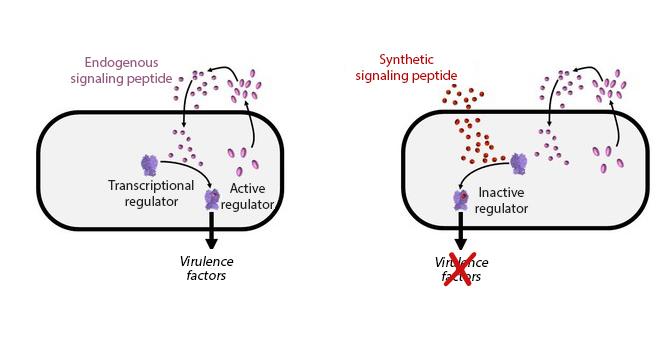Food, Global Health Reading time 2 min
Disrupting cell-cell communication to suppress virulence in the bacterium Bacillus cereus
Published on 14 August 2018

In Gram-positive bacteria, some functions are regulated by cell-cell communication systems, which are called quorum-sensing systems. The bacterial pathogen Bacillus cereus causes food poisoning in humans. It can also lead to hospital-acquired infections in at-risk populations (notably the newborn, elderly, or immunocompromised). In this species, the PlcR-PapR system controls transcription of the main virulence genes. PapR is the signaling peptide, and PlcR is the transcriptional regulator. INRA researchers partnered with scientists at the Hebrew University of Jerusalem to inhibit the PlcR-PapR system because of the key role it plays in B. cereus pathogenicity.
Bacterial communication: from quorum sensing to quorum quenching
For the last several years, we have known that bacteria can communicate with each other and change their behaviour in response to cell density. The underlying process is called quorum sensing, or QS. In QS, bacteria synthesise and secrete chemical signals that are recognised by neighbouring bacteria. The result is a synchronised response by the bacterial community, via genetic regulatory mechanisms. Virulence factor expression, sporulation, production of antifungals and antibiotics, and biofilm formation are examples of QS-regulated functions.
It is possible to interfere with or even suppress QS-controlled functions by targeting the signaling molecules (e.g., by degrading or blocking them). This strategy is known as quorum quenching.
Drawing on biochemistry and genetics, the researchers created synthetic peptides that were derived from PapR. They then showed that some of these peptides could inhibit the PlcR-PapR system in B. cereus and, consequently, the production of virulence factors.
The peptides did not affect bacterial growth. However, they did block PlcR activity when they were used early on during development. PapR, the endogenous signaling peptide, cannot counteract the inhibition process. This result indicates that the synthetic peptides can act for an extended period during B. cereus growth.
This is the first time that inhibitors of B. cereus quorum sensing have been identified. The peptides' creation and functionality are a proof of concept and key step in the process of characterising intercellular communication systems in bacteria. For several years, INRA researchers, and their national and international collaborators, have been leading the way in this scientific field. The work described here can inform the development of novel medical treatments, in which quorum quenching is used to reduce or fully suppress the virulence of bacterial pathogens. Such strategies could serve as alternatives to attempts to eliminate bacteria via antibiotics, bactericides, or bacteriostats, whose use selects for microbial resistance.

Avishag Yehuda, Leyla Slamti, Racheli Bochnik-Tamir, Einav Malach, Didier Lereclus and Zvi Hayouka Turning off Bacillus cereus quorum sensing system with peptidic analogs Chemical Communications, 2018 DOI: 10.1039/C8CC05496G
